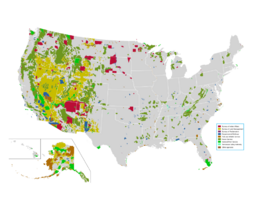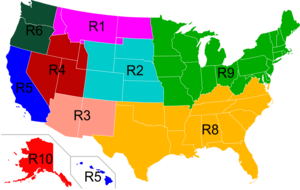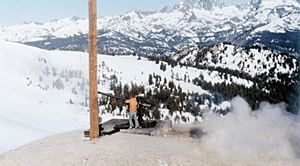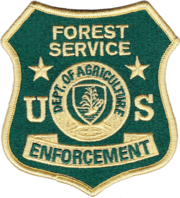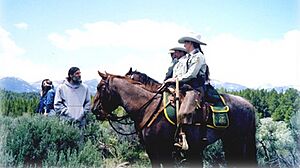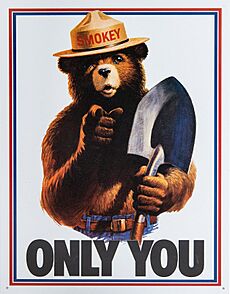United States Forest Service facts for kids
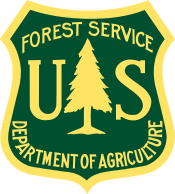
Logo of the U.S. Forest Service
|
|
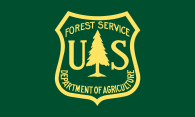
Flag of the U.S. Forest Service
|
|
| Agency overview | |
|---|---|
| Formed | February 1, 1905 |
| Preceding agency |
|
| Jurisdiction | Federal government of the United States |
| Headquarters | Sidney R. Yates Building 1400 Independence Ave SW Washington, D.C. |
| Employees |
|
| Annual budget | $9.32 billion (additionally, $2.30 billion for wildfire adjustment) (FY 2024) |
| Minister responsible |
|
| Agency executives |
|
| Parent agency | U.S. Department of Agriculture |
The United States Forest Service (USFS) is a part of the U.S. Department of Agriculture. Its job is to manage and protect America's 154 national forests and 20 national grasslands. This is a huge area of land, covering 193 million acres (780,000 km2).
The Forest Service has several main jobs. These include managing the National Forest System, helping states and private landowners, running business operations, and doing research. It manages about a quarter of all land owned by the federal government.
Contents
History
The story of the Forest Service began in 1876. The U.S. government created a special office to check on the health of the nation's forests. In 1881, this office grew into the Division of Forestry.
A big step happened with the Forest Reserve Act of 1891. This law allowed the government to set aside land as "forest reserves." In 1905, another important law, the Transfer Act of 1905, moved these reserves to a new agency. This agency was named the United States Forest Service.
Gifford Pinchot became the first leader, called the Chief Forester, under President Theodore Roosevelt.
Over the years, other government agencies were created to manage different types of land. For example, the National Park Service was made in 1916 to run parks like Yellowstone. The Bureau of Land Management was formed in 1946. But the Forest Service has remained in charge of the national forests.
How the Forest Service is Organized
A Big Picture Look
The Forest Service has a large budget to do its work. It employs thousands of people who work in offices in Washington, D.C., and out in the forests and grasslands.
The agency's mission is to keep the nation's forests and grasslands healthy and productive for everyone, now and in the future. Their motto is "Caring for the land and serving people."
The daily work of the Forest Service is a balancing act. They manage the use of resources like timber, protect nature, and provide places for people to have fun. This includes:
- Taking care of 193 million acres (780,000 km2) of land.
- Managing thousands of recreation sites.
- Maintaining over 143,346 miles (230,693 km) of trails.
- Looking after nearly 374,883 miles (603,316 km) of roads.
- Fighting wildfires.
Leadership and Research
The head of the Forest Service is called the Chief. This person is a career government employee, not a politician. The Chief's office in Washington, D.C., sets the main goals for the agency.
The Forest Service also has a large research department. Scientists study everything about forests, from trees and animals to water and soil. This research helps the agency make smart decisions to keep forests healthy. They have research stations across the country and a special Forest Products Laboratory in Wisconsin that studies how to use wood in better ways.
Regions Across the Country
To manage such a large area, the Forest Service is split into nine regions. Each region covers a large part of the country and is led by a regional forester.
- Northern Region (R1): Based in Missoula, Montana.
- Rocky Mountain Region (R2): Based in Golden, Colorado.
- Southwestern Region (R3): Based in Albuquerque, New Mexico.
- Intermountain Region (R4): Based in Ogden, Utah.
- Pacific Southwest Region (R5): Based in Vallejo, California.
- Pacific Northwest Region (R6): Based in Portland, Oregon.
- Southern Region (R8): Based in Atlanta, Georgia.
- Eastern Region (R9): Based in Milwaukee, Wisconsin.
- Alaska Region (R10): Based in Juneau, Alaska.
National Forests and Ranger Districts
Each region is made up of several national forests or grasslands. A forest supervisor is in charge of each one.
The forests are then divided into smaller areas called ranger districts. There are over 600 ranger districts, and this is where most of the on-the-ground work happens. District rangers and their staff build trails, run campgrounds, and manage the health of the forest and its wildlife.
Main Jobs of the Forest Service
The National Forest System
The 193 million acres (780,000 km2) of public land managed by the agency is called the National Forest System. These lands are not just forests. They also include grasslands, mountains, and even glaciers in Alaska.
A huge part of this job is managing wildfires. The Forest Service has thousands of wildland firefighters. During fire season, they work with other government groups to put out fires and keep people safe.
Law Enforcement & Investigations
The Forest Service has its own police force, called Law Enforcement & Investigations (LEI). These officers protect natural resources, visitors, and Forest Service employees. They patrol the vast national forests and grasslands.
There are two main types of officers:
- Law Enforcement Officers (LEOs): These are the uniformed officers you might see patrolling in trucks or on horseback. They enforce laws and make sure people are using the forests safely.
- Special Agents: These are detectives who investigate more serious crimes, like setting fires on purpose (arson) or major theft of natural resources.
To cover all this land, officers use 4x4 trucks, SUVs, horses, K-9 units (police dogs), helicopters, snowmobiles, and boats.
As of 2025, eight special agents and one K-9 have sadly been killed while doing their jobs.
Helping Others Care for Forests
The Forest Service doesn't just manage public land. It also has a program to help private landowners, states, and Native American tribes care for their own forests. They offer money and expert advice to help protect these lands from wildfires, insects, and diseases.
Responding to Modern Challenges
Fighting Wildfires
For many years, the Forest Service has worked to prevent unwanted wildfires. In 1944, they created a famous character to help teach people about fire safety: Smokey Bear.
Smokey's famous slogan, "Only YOU can prevent forest fires," is one of the most recognized in America. The campaign has been very successful in reducing the number of fires started by people.
Today, fighting wildfires is one of the agency's biggest and most expensive jobs. Sometimes, more than half of the Forest Service's budget is used for fighting fires.
Dealing with Climate Change
The climate is changing, and this affects forests with more wildfires, droughts, and insect outbreaks. In 2023, the Forest Service began working on new rules to help national forests become more resilient to these changes. The goal is to make sure the forests can survive and stay healthy for future generations.
The agency is also looking at ways to use national forests to help with climate change. One idea is called carbon capture. This involves storing carbon dioxide deep underground so it doesn't go into the atmosphere.
See also
 In Spanish: Servicio Forestal de los Estados Unidos para niños
In Spanish: Servicio Forestal de los Estados Unidos para niños
- Architects of the United States Forest Service
- Environmental history of the United States
- Forest ranger
- Forests of the United States
- List of national forests of the United States
- National Forest Foundation
- Wildfire suppression


